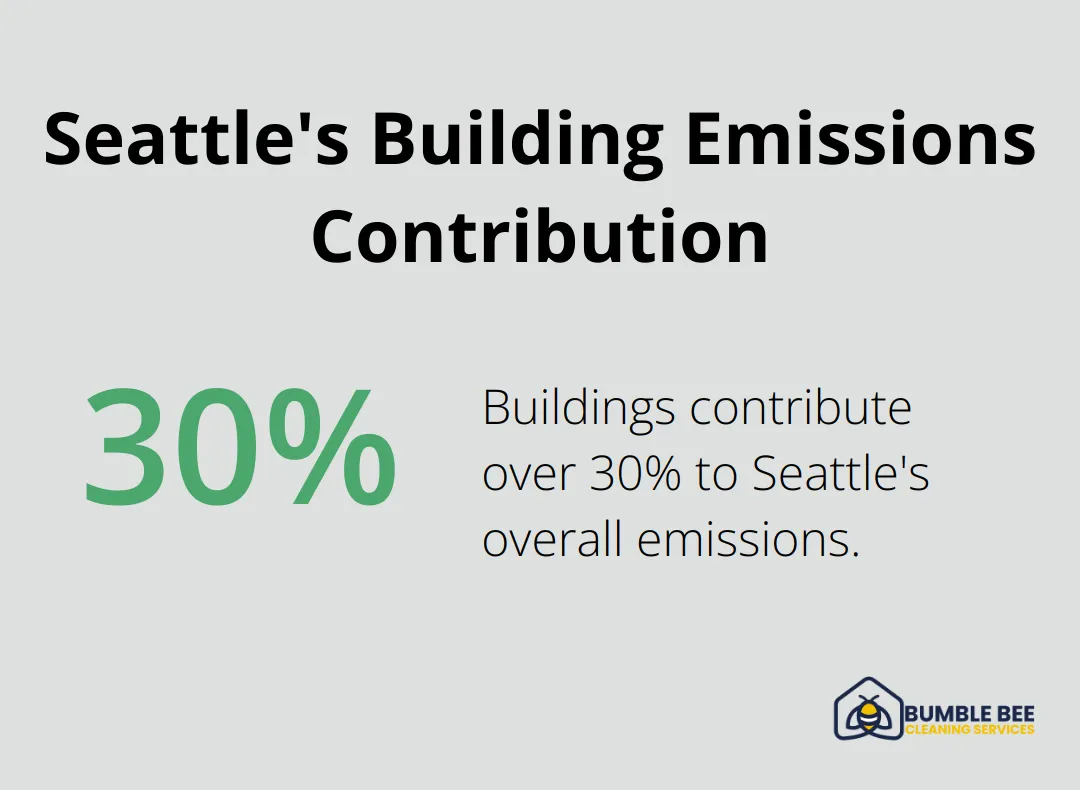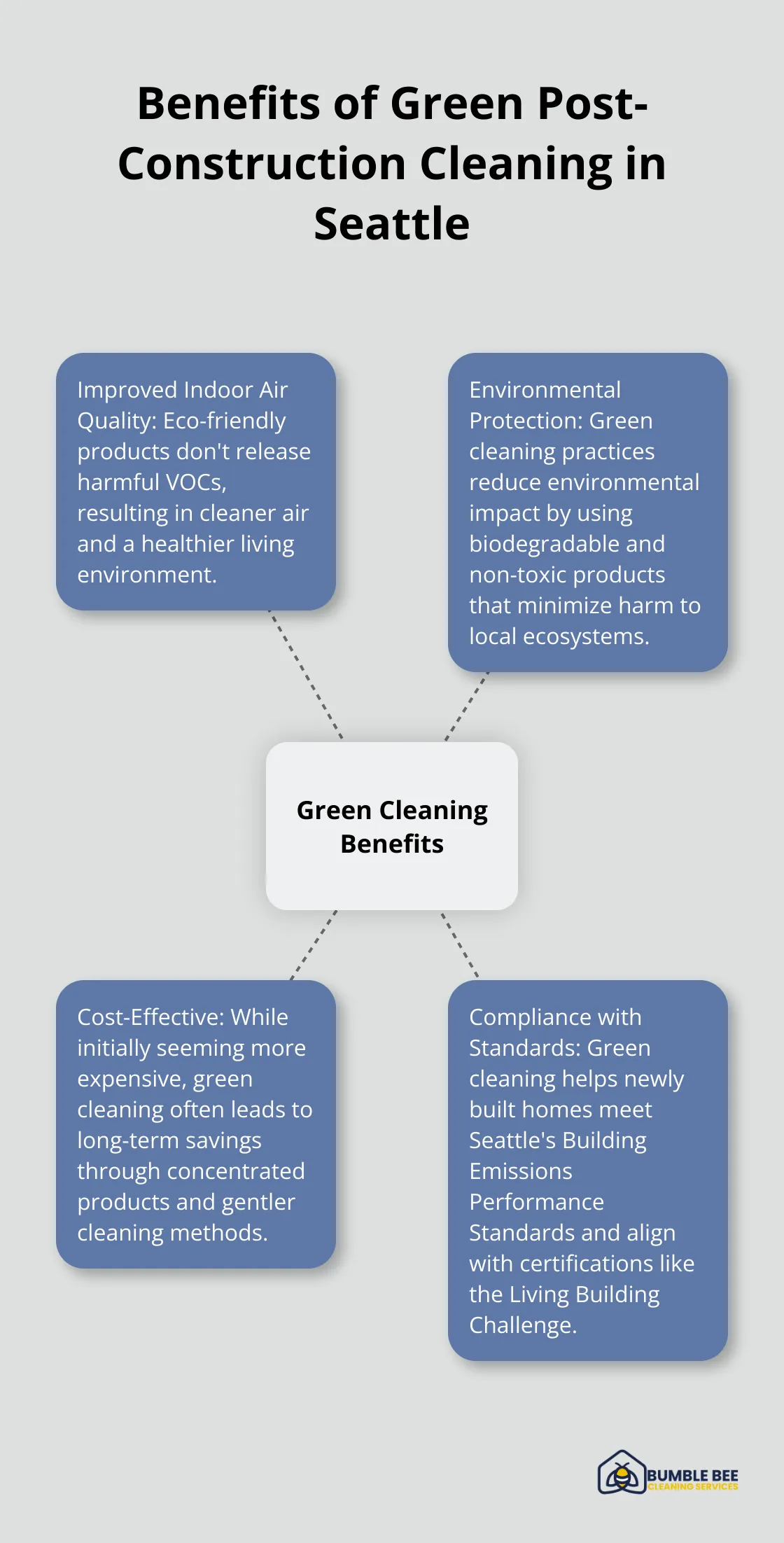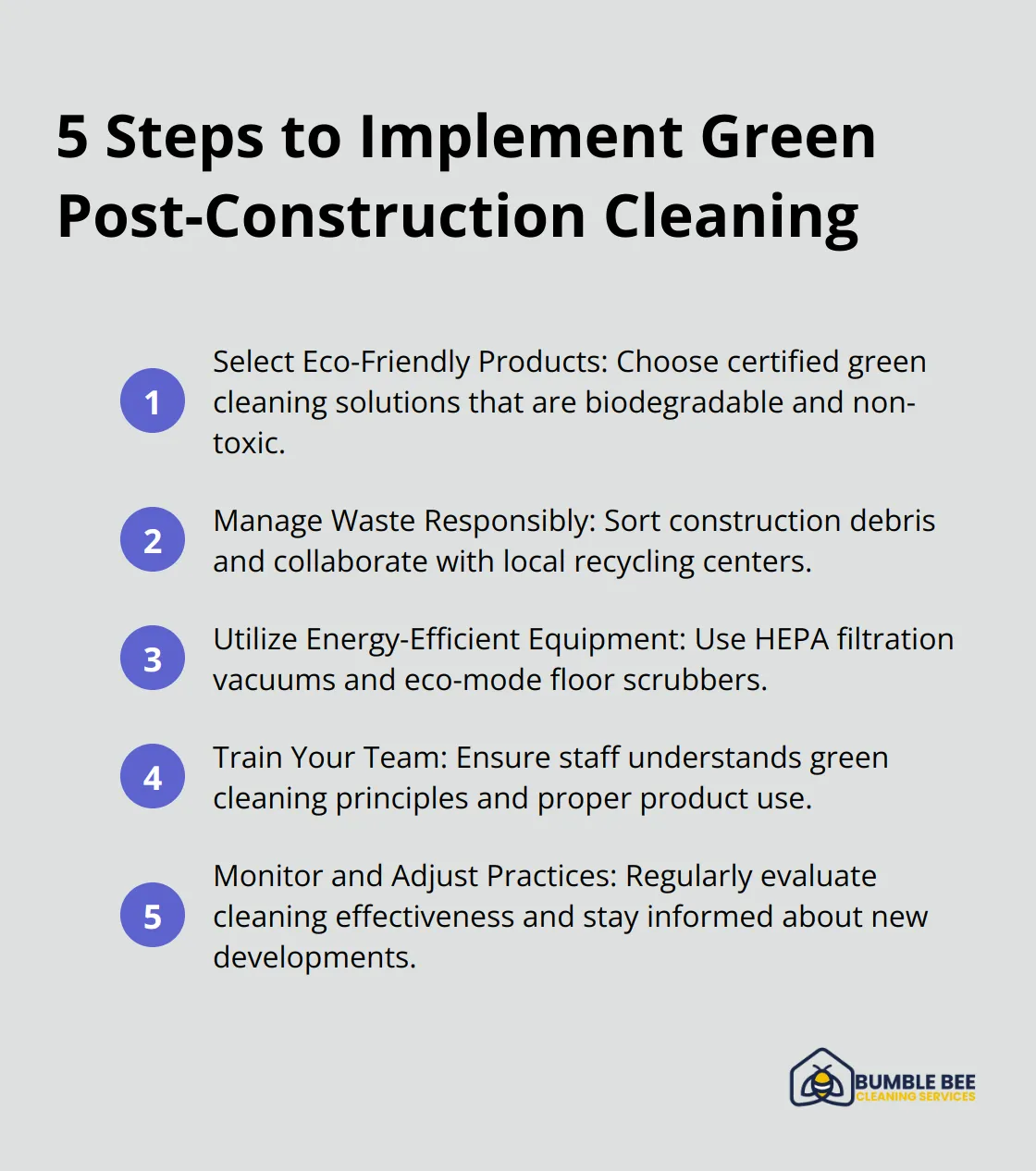Seattle’s commitment to sustainability is reshaping the construction industry, and we at Bumble Bee Cleaning Services are at the forefront of this green revolution.
Eco-friendly construction practices are becoming increasingly popular, with post-construction cleaning playing a vital role in creating healthier, more sustainable homes.
This shift towards green cleaning methods not only benefits the environment but also improves indoor air quality for new homeowners.
Why Seattle Leads the Green Cleaning Revolution
A City-Wide Push for Sustainability
Seattle stands at the forefront of environmental initiatives, setting new standards for the rest of the country in post-construction cleaning. The city’s commitment to sustainability has ignited a green revolution in the cleaning industry.
Seattle’s ambitious climate action plan aims to achieve carbon neutrality by 2050, with a strong focus on reducing emissions from buildings. This goal has triggered a surge in demand for eco-friendly construction and cleaning practices.
The Seattle Office of Sustainability & Environment reports that buildings contribute to over 30% of the city’s overall emissions. This startling statistic has prompted a shift towards greener building standards and post-construction cleaning methods.

The Impact of Seattle’s Building Emissions Performance Standard
In 2021, Seattle introduced the Building Emissions Performance Standard, a game-changing policy that mandates carbon neutrality for nonresidential and multi-family buildings over 20,000 square feet by 2050. This standard has significantly influenced the construction and cleaning industries, pushing companies to adopt more sustainable practices.
Many cleaning companies (including Bumble Bee Cleaning Services) have embraced this change, aligning their post-construction cleaning methods with Seattle’s green standards. The use of eco-friendly products and energy-efficient equipment supports the city’s sustainability goals while providing top-notch cleaning services.
Green Certifications Drive Change
The Living Building Pilot program in Seattle has transformed the construction and cleaning industries. This program incentivizes developers to pursue the Living Building Challenge, one of the most rigorous green building certifications worldwide.
As a result, demand has increased for cleaning companies that can maintain these high environmental standards post-construction. Many cleaning teams now train to meet these stringent requirements, ensuring that newly constructed buildings maintain their green certification status.
The Role of Eco-Friendly Products
The shift towards green post-construction cleaning in Seattle has sparked innovation in cleaning products. Companies now develop and use non-toxic, biodegradable cleaning solutions that effectively clean without harming the environment.
These eco-friendly products (often made from plant-based ingredients) not only reduce the environmental impact but also improve indoor air quality for new homeowners. This dual benefit has made green cleaning products a staple in Seattle’s post-construction cleaning industry.
Energy-Efficient Cleaning Equipment
The green revolution in Seattle’s cleaning industry extends beyond just products. Cleaning companies now invest in energy-efficient equipment that reduces power consumption while maintaining high cleaning standards.
From HEPA filter vacuums to microfiber mops, these tools not only clean effectively but also contribute to the overall sustainability of the cleaning process. This shift towards energy-efficient equipment aligns perfectly with Seattle’s broader goals of reducing energy consumption and carbon emissions.
As Seattle continues to lead the way in sustainable practices, the post-construction cleaning industry evolves to meet these new standards. The next section will explore the tangible benefits that green post-construction cleaning brings to Seattle’s homes and residents.
How Green Post-Construction Cleaning Benefits Seattle Homes

Improved Indoor Air Quality
Green cleaning products, certified by Green Seal, do not release volatile organic compounds (VOCs), which can cause respiratory issues. This enhances the air quality in newly built Seattle homes. Traditional cleaning products often release VOCs that linger in the air, potentially causing respiratory issues and headaches. Eco-friendly cleaning products contain no harsh chemicals or VOCs, resulting in cleaner air and a healthier living environment for new homeowners.
Environmental Protection
Green cleaning practices reduce the environmental impact of post-construction cleaning. Traditional cleaning methods often use harsh chemicals that harm local ecosystems when they enter waterways. Eco-friendly cleaning products (biodegradable and non-toxic) minimize this impact. For example, plant-based cleaning solutions (instead of petroleum-based products) reduce carbon emissions and support sustainable agriculture.
Green cleaning companies also use energy-efficient equipment and practices. This includes HEPA filter vacuums that remove dust and allergens effectively while consuming less power. Microfiber mops require less water for cleaning, further conserving resources.
Cost-Effective in the Long Run
Many assume green cleaning costs more, but it often leads to savings over time. Eco-friendly products are typically concentrated, which means less product per cleaning session. This reduces purchase frequency and lowers transportation costs.
Green cleaning practices can also extend the life of surfaces and materials in a home. Harsh chemicals in traditional cleaning can damage surfaces over time, leading to costly repairs or replacements. Gentle, eco-friendly products help maintain surface integrity, saving homeowners money on maintenance and replacements.
Compliance with Seattle’s Green Standards
Seattle’s Building Emissions Performance Standards is a key strategy, guiding the city’s largest buildings towards reduced emissions. Green post-construction cleaning helps ensure that newly built homes meet these standards.
The Seattle Building Emissions Performance Standard requires buildings to achieve carbon neutrality by 2050. Choosing green cleaning services contributes to this goal from the first day of occupancy.
Green cleaning practices also align with certifications like the Living Building Challenge (incentivized by Seattle’s Living Building Pilot program). This can increase property value and appeal to environmentally conscious buyers in the future.
As we move forward, it’s clear that green post-construction cleaning offers numerous benefits for Seattle homes. But how can homeowners and builders implement these practices effectively? The next section will explore best practices for green post-construction cleaning in Seattle.
How to Implement Green Post-Construction Cleaning

Select Eco-Friendly Products
The selection of environmentally friendly cleaning products stands at the core of green post-construction cleaning. Products certified by Green Seal do not release volatile organic compounds (VOCs), which can cause respiratory issues. Simple Green’s All-Purpose Cleaner (biodegradable and non-toxic) serves as an excellent choice for post-construction cleanup.
Avoid products that contain ammonia, chlorine, or phosphates. Plant-based cleaners offer effective alternatives. Seventh Generation provides a range of eco-friendly cleaning solutions that work well in post-construction environments.
Manage Waste Responsibly
Responsible waste management plays a key role in green post-construction cleaning. Sort construction debris into recyclable and non-recyclable materials. Wood, metal, and cardboard often qualify for recycling.
Collaborate with local recycling centers that specialize in construction waste. In Seattle, companies like DTG Recycle offer comprehensive construction waste recycling services. These partnerships can help divert a significant portion of waste from landfills.
Utilize Energy-Efficient Equipment
The use of energy-efficient cleaning equipment reduces the carbon footprint of post-construction cleaning. HEPA filtration vacuums capture 99.97% of particles common in post-construction environments. The Nilfisk GM80 HEPA vacuum (known for its high efficiency and low energy consumption) stands out as a popular choice among green cleaning professionals.
For larger areas, ride-on floor scrubbers with eco-mode settings provide excellent cleaning results while using less water and energy.
Train Your Team
Proper training ensures effective green post-construction cleaning. Cleaning staff should understand the principles of green cleaning and the correct use of eco-friendly products.
Certification in green cleaning practices elevates the team’s expertise. The Green Clean Institute offers comprehensive training programs that cover all aspects of eco-friendly cleaning.
Monitor and Adjust Practices
Regular evaluation of cleaning practices helps maintain high standards of green post-construction cleaning. Monitor the effectiveness of eco-friendly products and adjust usage as needed. Keep track of waste reduction efforts and energy consumption to identify areas for improvement.
Stay informed about new developments in green cleaning technology and products. The field of eco-friendly cleaning evolves rapidly, and staying current ensures the use of the most effective and environmentally friendly methods.
Final Thoughts
Green post-construction cleaning has revolutionized Seattle’s approach to eco-friendly construction. This shift improves indoor air quality for new homeowners and reduces the collective carbon footprint of the city. The use of non-toxic, biodegradable products and energy-efficient equipment aligns with Seattle’s ambitious climate goals.
The future of green cleaning in Seattle looks bright. As awareness grows and technology advances, more innovative eco-friendly cleaning solutions will emerge. This trend will likely influence all aspects of property maintenance beyond post-construction cleaning.
We at Bumble Bee Cleaning Services strive to provide top-notch eco-friendly cleaning services that meet high sustainability standards. Our team understands the importance of maintaining newly constructed spaces while minimizing environmental impact. The demand for green post-construction cleaning will increase as Seattle leads in sustainable urban development.
